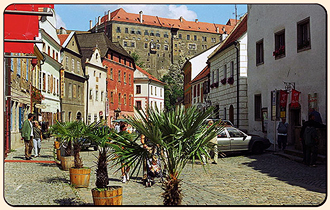
- Hradcany Quarter
- Prague Castle - The Castle Complex
- Lesser Town
- New Town
- Old Town
- Josefov - Jewish Quarter

Cesky KrumlovCesky Krumlov is the second largest castle complex in the Czech Republic. The town was built on the banks of the Vltava river, surrounding the originally Gothic castle, dating from the 13th century. It was founded by the family of Vitek. After they died out the property passed into the hands of the Lords of Rosenberg (1302 – 1602). During this time, the town and castle were engaged in a major reconstruction. The last two owners of the city, Petr and Vilem Vok, sold the lordship to Emperor Rudolf II So for a time it belonged to the Czech ruler. But it was soon sold again to another family, the Eggenbergs. This noble family died out in the beginning of the 18th century. From 1720 to 1947 it belonged to the Schwarzenbergs. The castle was then nationalized and it remains so until nowadays. The town became a well-known tourist and cultural centre and was
put on the list of UNESCO World Cultural and Natural Heritage sites.
It is definitely a 'must-see' when visiting the Czech Republic. After picking you up from your hotel, we drive for around two and half hours to reach the city of Cesky Krumlov, which is located in the south of Bohemia. This special tour is arranged in a car or in Mercedes Vito, people-carrier with special DVD equipment, for a group of 7 persons maximum. Prices are set for whole groups regardless of the number of people. During this full-day tour, you will see films and get a general idea of the city from the DVD. Our driver/ guide will be accompanying you to the city. You can discuss with her or him about the trip and matters of interest. We are driving to the upper parking place near the castle Cesky Krumlov, it is the start of our walking tour. We walk trough the Baroque garden with a theatre and step by step, explore all five courtyards inside of the castle. During the second part of the tour our driver/guide will take you to the historical center with narrow streets full of Gothic, Renaissance and Baroque houses. You will cross Vltava river and reach the main square of concord route. There is the end of the official tour and then you will have time for exploring the city on your own, shopping or resting in some of its beautiful restaurants. The tour finishes back in Prague on the place according to yur wish.
Baroque garden, theatreWe enter the Baroque garden, where we find the revolving theatre. Revolving stages are everywhere in the world, but here you can see an entire revolving auditorium, that turns with you. 70% of the performance takes place here, but from time to time the audience revolves instead. The summer palace next to stage is called Bellarie and is an example of the rococo style. CastleThe complex of the castle is built on a rock outcropping and devided into several parts – the Baroque theatre, Covered Bridge, Upper and Lower portions of the castle and five Castle Courtyards. The white building (V.courtyard) is a Baroque theatre, a very unique structure erected in 1680. The theatre has the original technical equipment, decorations, costumes and furniture, etc. LatranSo, we enter the city at Latran, the oldest section of the town. On every corner, at each step you see again and again the dominant Renaissance style. The painting you observe is called an envelope motive. Not to far from here (on the left) is an old brewery, originally dating to the 15th century. ParkanOn the other side of the bridge, Latran Street changes its name to Radnicni Street, which climbs up toward the square and the street to the left is Parkan. Parkan Lane leads to the left from the main route and there are several interesting and quite excellent restaurants with gardens along the river bank. The Square of Concord RouteThe facades and interiors of houses reminds one of the historic development since the founding of Cesky Krumlov, a period covering the Middle Ages until now. The Tourist Information Centre is located here as well. The first public fountain, made of stone, was built in the 16th century, before there was only a wooden one. The Plague Column was erected at the beginning of 18th century, as were many in villages and towns, to commemorate (and prevent a reoccurrence) of the plague epidemic. |
|||






